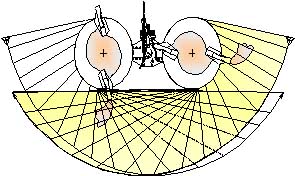|
All
KRM fertiliser spreaders use our Trend spreading system. This system
is unique in combining two spread patterns for the ultimate spreading
performance in-field and at the headland.
|
|
In
Field Spreading
|
|
Headland Spreading
|
|
|
|
|
|
A
true "Double Double Overlap" spread pattern is used
for in field work. The large diameter stainless steel discs
rotate towards each other giving maximum accuracy and tolerance.
|
|
Simply
by reversing the discs the back of the vane is brought into
use. The natural characteristic of this pattern ensures a
sharp cut of at the headland.
|
|
The "Double
Double Overlap" spread pattern offers the largest amount
of overlap possible and therefore the highest degree of tolerance
when spreading.
|
|
The
diagrams below demonstrate that the left hand disc applies fertiliser
across the full spread width as does the right hand disc, therefore
a true double overlap tramline to tramline across the full width
has taken place.
|
|
|
 |
|
| As
the machine spreads the next tramline another double overlap is applied.
It can now be seen that the area between the tramlines which has now
had its whole application has received 4 applications two from each
disc. In this way the spread pattern is built up little and often.
When spreading in the real world there are many factors that can affect
the evenness of spread, such as wind, uneven ground, material variations
and PTO speed fluctuations. By using the Double Double overlap system
where effectively 4 applications are being applied any external factors
will have a much smaller affect than they will with other spread systems
offering less overlap. |
|
| Tray
tests are regularly carried out by Bogballe the manufacturers who
have their own test hall. This is done to ensure the accuracy of their
machines and also that the spread charts supplied with machines are
up to date and include all fertiliser types. The diagram below shows
actual test hall data for a machine doing a tray test with only the
left hand disc spinning. As you can see an even triangular spread
pattern is achieved and fertiliser is spread across the full 24m spread
width |
|
|
|
The
next diagram in the sequence is showing just the right disc spreading
and again we have a very even triangular shaped spread pattern across
the full 24m spread width.
|
|
|
|
This
last diagram in the sequence shows the result when both disc's are
running together. The red line along the top indicates the overall
spreading result when the machine spread the adjacent two tramlines.
|
|
|
| The
diagram below shows what would happen if the spread pattern was overlapped
at different spread widths. It can be seen that at 24m which is our
target spread width the coefficient of variation (or evenness of spread)
is 4.5% an excellent result. What this diagram also shows is that
the accuracy of the machine is not lost if for some reason it is not
driven at 24m for example on grass. Where the actual spread width
may vary due to driving accuracy. It can be seen that the coefficient
of variation remains below 6% at all widths below 24m and only exceeds
10% at 28m. (Stripes start to become visible in a crop at 20%, KRM
do not publish spread charts for machines which give a coefficient
of variation worse than 10%). This highlights the tolerance the KRM
machine, all external factors such as PTO speed, sloping ground, material
size and wind, have the same effect in the field as driving at an
incorrect width. |
|
|
| |
| |